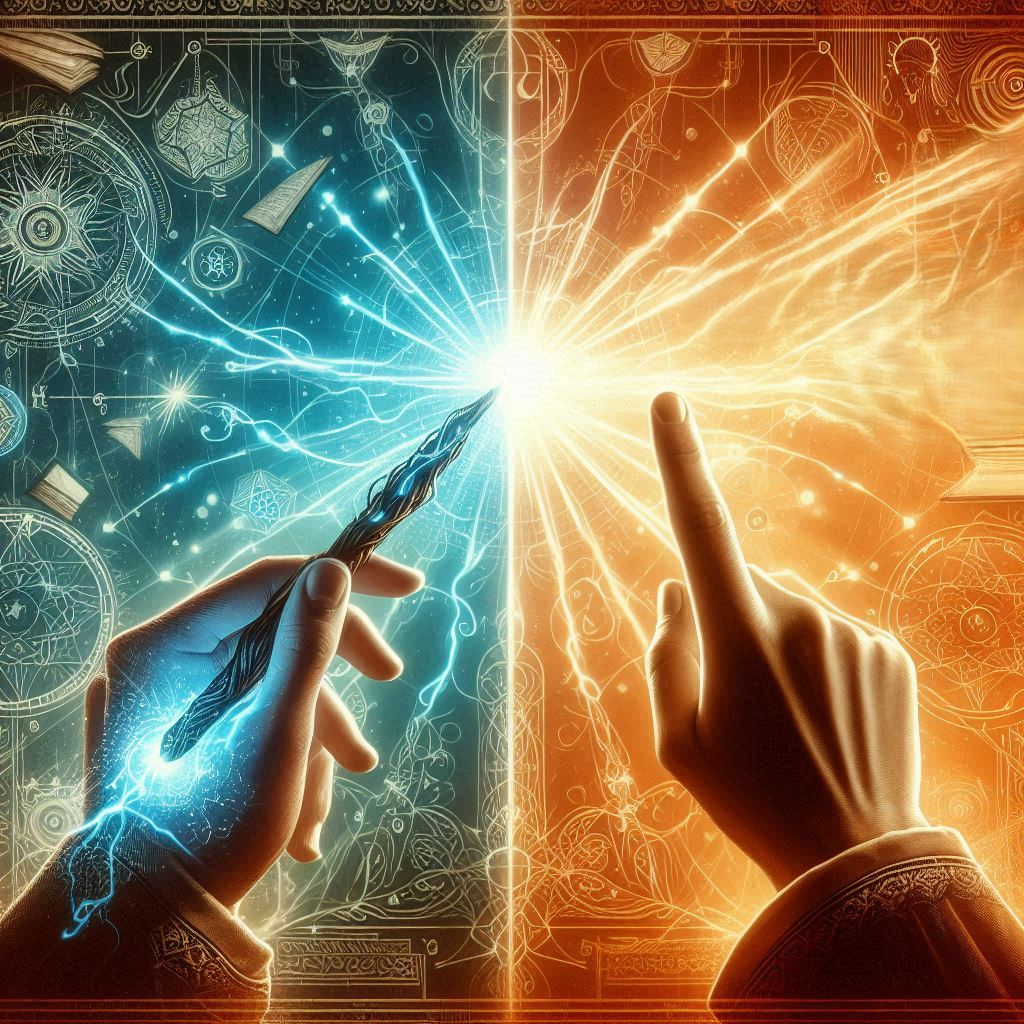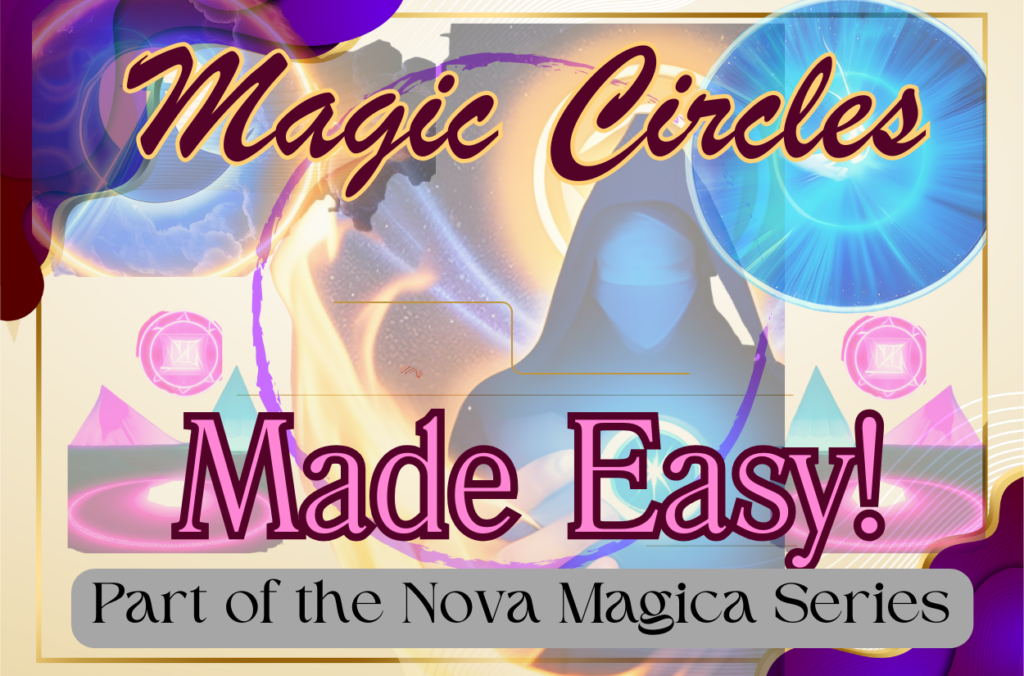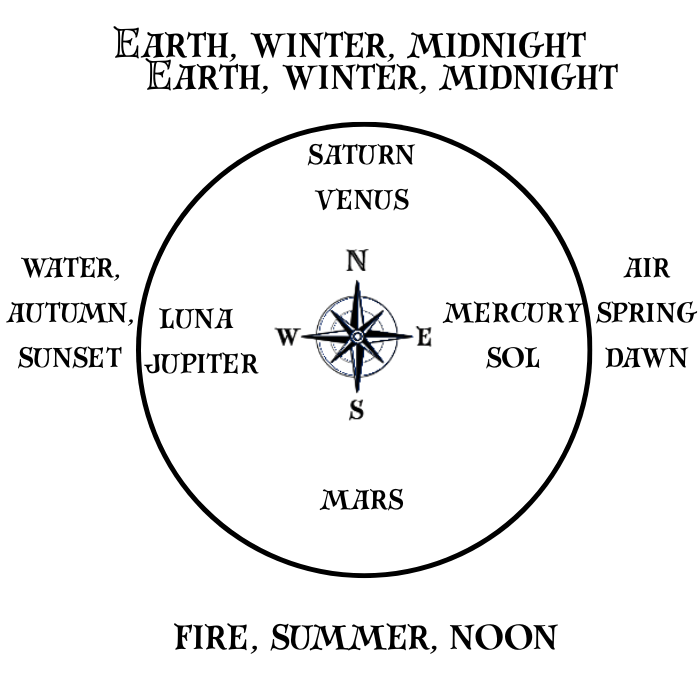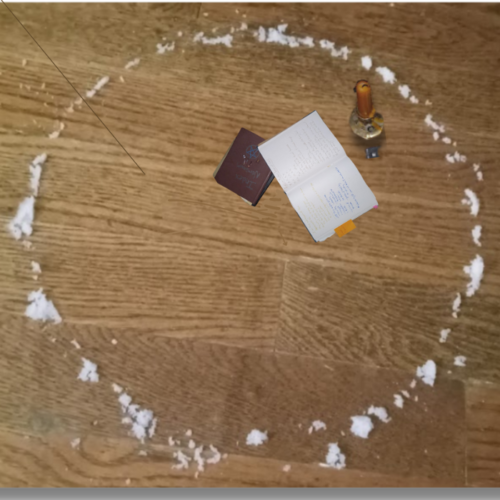This page is a quick reference sheet for magic circles. As with all things on this site, it will be added to and enhanced with time so be sure to check back periodically if looking for info relevant to magic circles, encirclement, or as the kids these days are calling it, circle magic.
First of All, Do You Cast a Circle or Raise a Circle?
Creating the magical circle can always be called initiating the circle, and the term opening the circle can be applied to the drawing or tracing process as well as the point at which actual wo\rk within the circle is to begin.
However casting and raising are two distinct techniques. As with all magical terminology this simple matter can be turned into a ludicrous debate with more fine points than the hair on a frog’s leg, but I refuse to indulge that level of minutia.
Let’s keep it simple and say:
- A cast circle is one that is placed upon the ground around the practitioner.
- A raised circle is placed in the air around the practitioner.
Having stated this, it is now reasonable to address the varying methods for actually making a magic circle.

Two Basic Forms of Magic Circles
According to me, there are essentially three methods for creating a magic circle and two forms of circles that can be created. The forms are energetic and material.
This is a bit deceptive if taken as absolute, because both energy and material are used in most cases. With these two headings we are referencing the primary modality involved with circle casting or raising.
Here’s what I mean:
If you visualize a circle forming in the air around you and your workspace, this is primarily an energetic technique, but it does involve the physical air in your space. I call this and similar methods, like projecting energy from your pointing finger or wand to make a circle, an energetic circle.
On the other hand, perhaps you pain a circle on the floor of your study or temple, or sprinkle crushed quartz around you in a circle. While using this material and performing physical work, you will also be projecting or conjuring a certain kind of energy in accordance with the magic to be done. However since paint or ink or crystal powder or salt or some other material is the key focal point I will call these circles material circles.
Wand or Hand?
If drawing or marking a circle on the floor you might use the marker or brush as a wand. I still consider it a good practice to trace back over the marked circle with projected energy, from a magic wand for example. This is your call of course.
As mentioned above, you might choose to visualize or imagine your circle forming which doesn’t require a wand or any pointing. Even when I visualize I might use the wand to channel energy, whether or not I ever point it at anything. This too is your personal decision.
If you choose to point and direct energy into your circle, you may use a wand of your choice, or you can use the pointer finger on your projective hand, or the hand you write, draw, and throw a ball with. Maybe you don’t throw balls, ever. If you’re thinking this right now, I suggest you are being a smart ass, but that’s fine as you are in good company if so.
Your projective, or dominant hand is the hand you would throw something with if your goal was to throw it far or hard. It is the hand you might use to punch the villain from your favorite movie if you had the chance.
The index or pointing finger of the projective hand is often called the “wand finger” by contemporary magicians.
Wands are great tools and items of correspondence as you can use wands made from different materials. Selenite wands, in addition to being generally badass, correlate with the moon, and juniper wands align with fire, to cite only two examples.
Your finger works quite well also and with practice you can generate not only vital force, but various other magical currents to then project via your arm, hand, and finger.

Where to Start and End Your Circle
Obviously when tracing a circle in the air or on the ground, drawing one with marker, sprinkling it with salt, or walking in a circle as you perform certain techniques, your starting point will also be your ending point. This point and the direction to trace or move for encircling vary among systems, traditions, and preferences.
I typically begin and end in the North, because it is the prime compass point and also the direction of the primary ruling planet within my personal astrology. I might just as easily start and finish in the East, for traditional purposes and because this is the direction of the rising sun, thus ideal for initiating any work.
I could further complicate things and tell you for nighttime work I may be prone to start and end my circle facing West, in the direction of sunset and the direction of lunar correspondence. Truthfully, I reserve the right to start the circle in different directions based on the kind of work I am doing, but north and east are my commonplace or go-to start and end points.
Which Way to Turn When Making the Circle?
I usually turn right or clockwise but may go left/counterclockwise to clear the energy of the room as I encircle. The latter approach I find useful if I don’t intend to do a lengthy banishing ritual ahead of my work and will settle for a circular wand stroke and “Hekas Ekas” or other incantational banishing.
Magicians may opt to turn right for solar work and left for lunar, and the same for any polar considerations (yin-yang, male-female, light-dark, et al.) It is also noteworthy that some practitioners will open the circle in one direction and then trace or move n the opposite direction to close the circle.
I tend to close the circle by either breaching the circumference with my arm or wand and declaring it done or simply walking out of it after my closing techniques.


Begin with a Clear and Singular Reason or Purpose
All these conditional concerns should remind us to always, always, always begin our circle for a clear reason or with a singular purpose. Yes, I know reason and purpose mean different things and that’s how I am using them here!
Either your personal reason or for the purpose to be fulfilled with the coming work need to be the focal point as you initiate the circle. Take a moment once the circle is finished to announce this intention and impress it upon the very malleable energy field within your circle.
Quarters of the Circle
The quarters of the circle, or the four equal-sized segments of the circle, typically resembling four slices of pie, are rarely taught or practiced. Instead, this term “quarters” usually refers to the four cardinal directional points of north, south, east, and west which are the centers of each quarter.
These directional points correspond to the four winds, four elements, the classical planets, and other aspects of magic according to different systems and traditions. Here are my quarters/directions with the correspondences I use, along with a few other valid formats.
!Dogma Alert! It might be most appropriate to note that planets aren’t necessarily tied to any specific point on the circle, and that only elements and winds, along with other correspondences including deities are pinned to the compass points. Often, however, magicians place planets in accordance with ruling elements, which can lead to a loose fixing of the planets with the directions. Kabbalists and ceremonialists have various other methods for placing the planets, including current astrological movements.

Elements and Planets at the Compass Points
In my own work I set earth in the north, fire in the south, air in the east, and water in the west, along with the traditional seasonal and time of day correspondences for each element (see below). The four winds obviously are paired with the correct direction. My planetary attributions are Saturn and Venus with north, Luna/Moon and Jupiter with west, Mars with south, Sol/Sun and Mercury with east. My arrangement is not unique but also varies slightly from the most commonly used formats found in contemporary Pagan traditions and magical systems.
For the trans-Saturn planets of Uranus, Neptune, and Pluto I use intermediate or cardinal directions that vary depending on the exact nature of my work. I’ll cover this in a separate article at some point. I don’t move beyond these three modern additions in my own work, retaining Pluto as a planetary power and declining to chase down every damn rock and ice cube the Kuiper belt has to offer. I’m a conjurer or sorcerer if we’re being fancy, a wizard if I seek to flatter myself, but in any case, not an astrologist nor even an astrologer.
Here is an image representation of my circle with directional correspondences.

Microcosmic or Macrocosmic Circles
The foundation I laid out above is a microcosmic, or pentagram-based formula. This is often said to be a microcosmic system, as the pentagram represents the awakened human being and the natural order.
On the other hand, the hexagram represents the soul and the celestial or divine order of the planets and signs of the zodiac, which is called the macrocosm. There are specific formula for magic circles that focus on macrocosmic or hexagram operations.
Perhaps to avoid additional complexity, or maybe simply because I find the pentagram layout sufficient for all my work, I no longer utilize hexagram-centric directional attributions for the magic circle. After all, the pentagram was used in ancient Mesopotamia to symbolize the five planets (meaning the classical seven minus the sun and moon, which the Sumerians understood to be different from the other planetary bodies). By standardizing planetary channels via the cardinal compass points I have made superfluous the need for an entirely distinct macrocosmic format.
Varying Interpretations
Please understand these are not strict rules, but merely my own conventions, resulting from what I was taught plus experience I gained through practice, rounded off, reduced, and enhanced by gnosis and inspiration. There are many other possible approaches.
Obviously the directional correspondences are symbolic in nature. No single direction on a map rules or controls any elemental energy or planetary power! Such systems create focal points and through repetition build a base of power the magician can draw upon for ongoing work.
Apply the knowledge you gain, along with your personal insights, to arrange your own magic circle. You have to, as the saying goes, start somewhere of course, and so I offer my method as that starting point if you like.
I also invite you to check out my book on magic circles, wherein I cover MUCH more than directions. I am willing to bet your idea of what the magic circle and the truth about this amazing tool are two different things, and I dare you to get my book and see for yourself.

